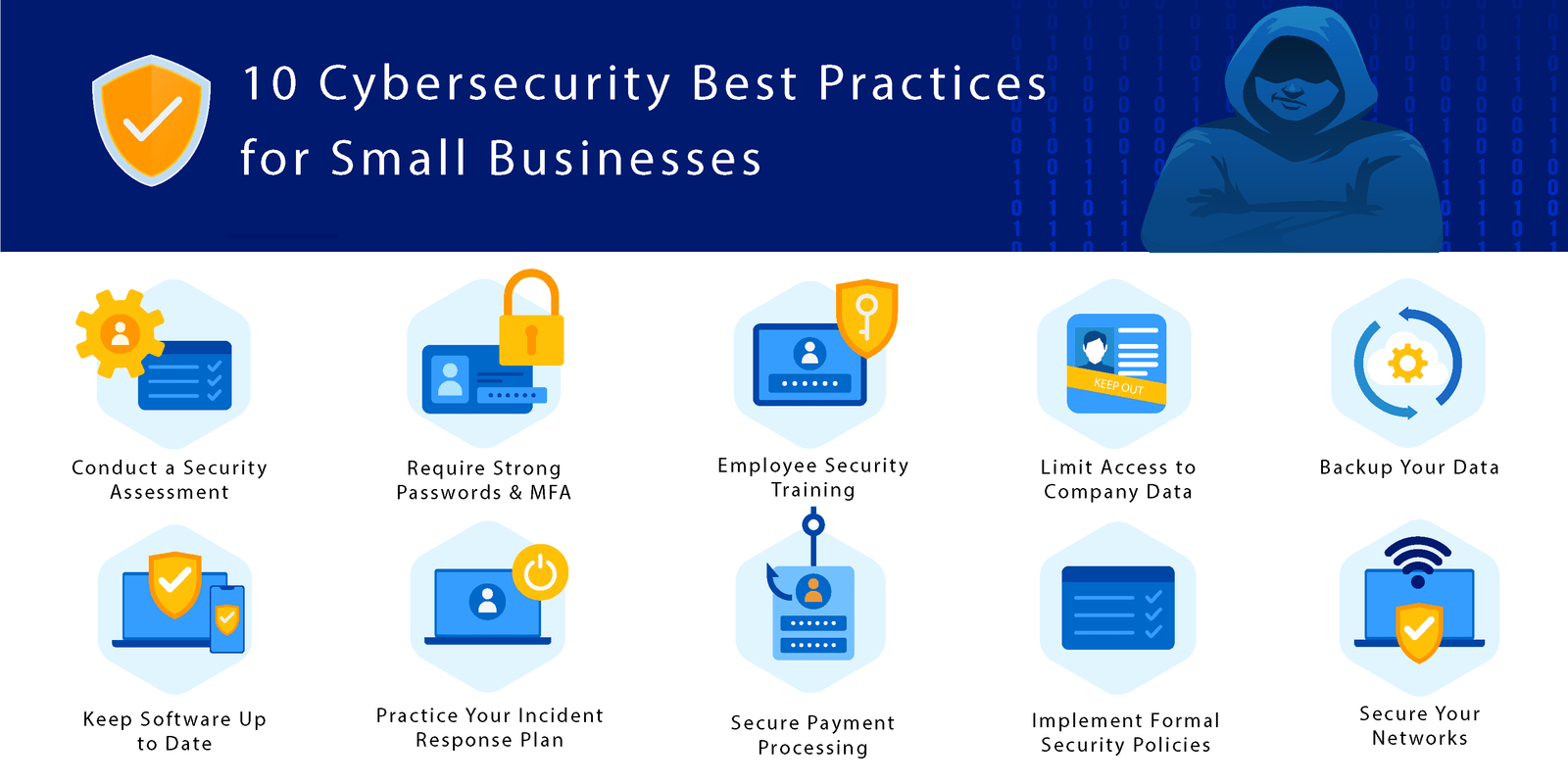In today’s digital landscape, safeguarding sensitive information and protecting against cyber threats has become an imperative for businesses of all sizes. Whether it’s the risk of data breaches, malware attacks, or phishing attempts, the consequences of inadequate cybersecurity measures can be detrimental. So, how can businesses ensure they are adequately protected? In this article, we will explore some of the best cybersecurity practices that businesses can implement to mitigate risks and keep their valuable data secure. In today’s digital age, cybersecurity has become paramount for businesses of all sizes. With an increasing number of cyber threats targeting organizations, it is crucial to implement strong cybersecurity practices to protect sensitive data and maintain the trust of customers and clients. In this article, we will explore the best cybersecurity practices that businesses should follow to enhance their security posture and mitigate potential risks.
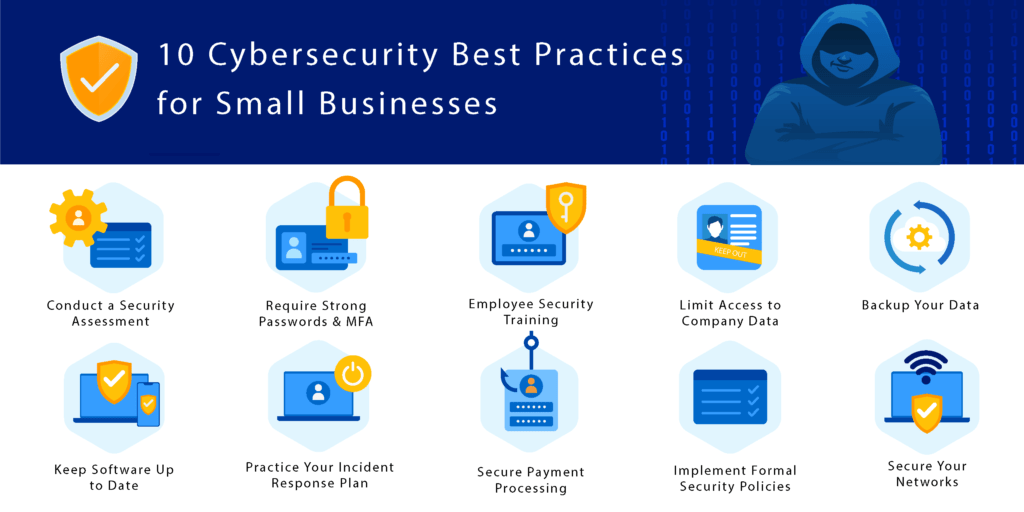
This image is property of www.psmpartners.com.
Implement Strong Password Policies
Use complex passwords
One of the most basic yet essential cybersecurity practices is to use complex passwords. Weak passwords are easy targets for hackers, and they can quickly compromise an entire system. By ensuring that employees create strong passwords, businesses can significantly reduce the risk of unauthorized access to their networks and data. Encourage the use of passwords that are at least eight characters long and include a combination of letters (both uppercase and lowercase), numbers, and special characters.
Require regular password updates
In addition to using complex passwords, businesses should also enforce regular password updates. Requiring employees to change their passwords periodically helps to prevent the reuse or guessing of old passwords. This practice adds an extra layer of security and reduces the likelihood of a successful cyber attack. Remind employees to choose unique passwords for each account and avoid using personal information that can be easily guessed or obtained.
Use multi-factor authentication
Multi-factor authentication (MFA) provides an added layer of security beyond passwords. It requires users to provide multiple forms of identification to authenticate their identity. This can include something the user knows (such as a password), something they have (such as a smartphone or token), or something they are (such as fingerprint or face recognition). By implementing MFA, businesses can significantly reduce the risk of unauthorized access, as even if a password is compromised, the additional factor of authentication acts as a deterrent.
Train Employees on Cybersecurity
Provide regular cybersecurity training
Employees are often the weakest link in an organization’s cybersecurity defenses. They are the ones who interact with systems, handle sensitive data, and are targeted by phishing attacks. Therefore, it is crucial to provide regular cybersecurity training to educate employees about the latest threats and best practices. Through training sessions, employees can learn to recognize and report suspicious activities, identify phishing scams, and understand their role in maintaining a secure work environment.
Teach employees to identify phishing scams
Phishing is a prevalent cyber attack method where attackers trick individuals into revealing sensitive information or downloading malicious software. By teaching employees how to identify phishing scams, businesses can significantly reduce the risk of falling victim to such attacks. Train employees to be cautious of suspicious emails, avoid clicking on unknown links, and verify the legitimacy of requests for sensitive information. Regular reminders and simulated phishing exercises can help reinforce these lessons and keep employees vigilant.
Promote safe browsing habits
Unsafe browsing habits can expose businesses to various cybersecurity risks, including malware infections and data breaches. Promote safe browsing habits among employees by encouraging the use of secure websites (indicated by HTTPS), avoiding downloads from untrusted sources, and being cautious while accessing sensitive data on public networks. Regularly remind employees to keep their browsers and software up to date with the latest security patches to minimize vulnerabilities.
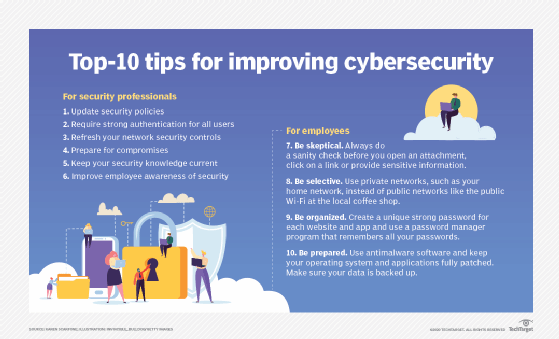
This image is property of cdn.ttgtmedia.com.
Keep Software and Systems Updated
Apply patches and updates promptly
Software vendors regularly release patches and updates to address security vulnerabilities and improve overall functionality. It is essential for businesses to apply these patches promptly to ensure the security of their systems. Delaying updates increases the risk of exploitation by hackers who are continuously searching for vulnerabilities. Establish a system to regularly check for and install updates across all software and devices used within the organization.
Use reputable software vendors
When selecting software vendors for your business, it is crucial to prioritize reputable vendors who prioritize security. Conduct thorough research and evaluate the vendor’s track record in terms of addressing security vulnerabilities and actively maintaining their products’ security posture. Choosing trusted vendors significantly reduces the risk of using software that may contain hidden vulnerabilities or backdoors that can be exploited by malicious actors.
Regularly scan for vulnerabilities
Implementing regular vulnerability scans across your systems is an effective way to identify and address potential security weaknesses. Vulnerability scanning tools can identify outdated software, misconfigurations, and other vulnerabilities that may be exploited by attackers. Regular scanning helps businesses stay ahead of potential threats and allows for prompt remediation before any damage occurs.
Implement Firewalls and Intrusion Detection Systems
Set up a robust firewall
A firewall acts as the first line of defense in preventing unauthorized access to a network. It monitors incoming and outgoing network traffic, blocking potential threats and allowing authorized traffic to pass through. Implementing a robust firewall helps protect sensitive data, applications, and systems from unauthorized access. Configure the firewall to restrict access only to necessary ports and protocols, and regularly review and update firewall rules to align with evolving security requirements.
Install intrusion detection software
Intrusion detection software (IDS) helps in identifying and responding to potential threats or malicious activities occurring within a network. By analyzing network traffic and system logs, IDS can detect unauthorized access attempts, malware infections, and other suspicious behaviors. IDS complements the firewall by providing real-time monitoring and alerting of potential security incidents, enabling businesses to respond promptly and minimize the impact of an attack.
Monitor network traffic for suspicious activity
Continuous monitoring of network traffic is essential to identify and respond to potential security incidents. Implementing a network monitoring system allows businesses to track and analyze data flows, identify abnormal activities, and detect any signs of compromise or unauthorized access. By monitoring network traffic, businesses can detect and respond to security threats in real-time, preventing or minimizing any potential damage.
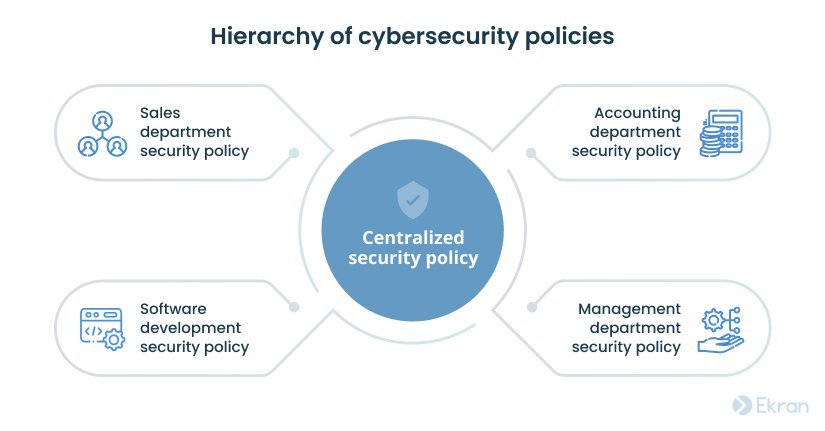
This image is property of ekran_site_uploads.storage.googleapis.com.
Encrypt Data
Use encryption for sensitive data
Encryption is a critical component of data protection, ensuring that even if data is intercepted, it remains unreadable and unusable to unauthorized individuals. Implement strong encryption algorithms to protect sensitive data stored on servers, databases, and other devices. Secure data both at rest and during transmission to provide end-to-end protection. Encryption should be used for sensitive financial information, customer data, intellectual property, and any other critical business data to minimize the risk of data breaches.
Implement secure communication protocols
Secure communication protocols, such as SSL/TLS, are vital for protecting data during transmission over networks. Ensure the use of these protocols while accessing sensitive information or conducting financial transactions online. SSL/TLS encryption establishes a secure connection between the user’s device and the server, preventing eavesdropping or unauthorized access to the transmitted data.
Regularly back up important data
Data backups are essential for disaster recovery and business continuity. Regularly backing up critical data mitigates the impact of data loss due to hardware failures, natural disasters, or cyber attacks. Maintain off-site backups in secure locations to ensure data can be restored if primary systems are compromised. Regularly test backup restoration processes to verify the integrity of the data and the effectiveness of backup procedures.
Secure Wi-Fi Networks
Change default Wi-Fi passwords
Wi-Fi routers often come with default usernames and passwords, making them vulnerable to unauthorized access. It is crucial to change these default credentials to a strong, unique password to secure the Wi-Fi network. Additionally, consider implementing Wi-Fi Protected Access 2 (WPA2) or newer encryption protocols to encrypt data transmitted over the network and prevent unauthorized access.
Use strong encryption protocols
To enhance the security of Wi-Fi networks, businesses should utilize strong encryption protocols. WPA2 or newer encryption protocols encrypt network traffic, making it significantly more challenging for attackers to intercept or access sensitive information. Regularly update Wi-Fi routers and access points to ensure they support the latest security standards and patch any vulnerabilities.
Separate guest and business networks
To ensure the security of business networks, it is essential to separate guest networks from internal business networks. This segregation helps prevent unauthorized access and protects sensitive data from potential threats originating from guest devices. By implementing separate networks and enforcing access controls, businesses can provide guests with internet access while maintaining the privacy and security of their own network.
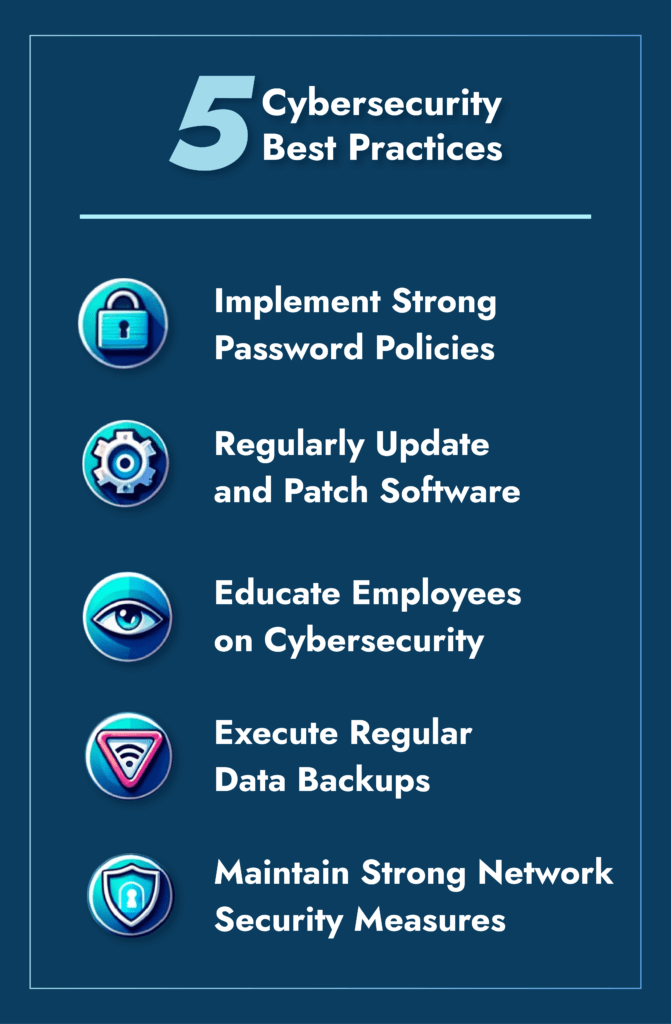
This image is property of online.champlain.edu.
Control Access to Data and Systems
Use strong authentication mechanisms
Implementing strong authentication mechanisms, such as biometrics or two-factor authentication (2FA), adds an extra layer of security when accessing sensitive data or systems. Biometric authentication, such as fingerprint or facial recognition, ensures that only authorized individuals can access critical resources. 2FA requires users to provide additional proof of their identity, such as a code sent to their mobile device, in addition to their password. By implementing these mechanisms, businesses can significantly reduce the risk of unauthorized access, even if passwords are compromised.
Restrict access to sensitive information
Not all employees require access to sensitive data. Implement strict access controls and restrict access to data based on the principle of least privilege (PoLP). Grant access only to those individuals who need it to perform their roles and responsibilities. Regularly review and update access permissions to ensure that they align with changing business needs and personnel changes.
Implement role-based access control
Role-based access control (RBAC) is a method of managing access privileges based on job roles within an organization. By assigning different roles to employees and granting associated access privileges, RBAC ensures that users have the necessary permissions to perform their duties without gaining unnecessary access to sensitive information. RBAC simplifies access management, improves security, and reduces the risk of accidental disclosure or unauthorized access.
Regularly Monitor and Audit Systems
Monitor logs for suspicious activity
Monitoring system logs is crucial in identifying and responding to potential security incidents. By analyzing logs, businesses can detect signs of unauthorized access attempts, malware infections, or unusual user behavior. Establish a centralized log management system to collect and monitor logs from various systems, applications, and network devices. Regularly review and analyze these logs to identify patterns or indicators of compromise and take appropriate action.
Perform regular vulnerability assessments
Regularly conducting vulnerability assessments helps identify security weaknesses and potential entry points for cyber attacks. Vulnerability assessment tools scan systems, devices, and applications for known vulnerabilities and provide recommendations for remediation. By addressing identified vulnerabilities proactively, businesses can reduce the risk of exploitation and enhance their overall security posture.
Conduct periodic security audits
Performing periodic security audits allows businesses to evaluate the effectiveness of their cybersecurity measures. Conduct comprehensive reviews of security policies, procedures, and controls to identify any gaps or areas that require improvement. A cybersecurity audit helps ensure compliance with industry regulations and standards, assess the effectiveness of security controls, and identify areas for further investment or training.
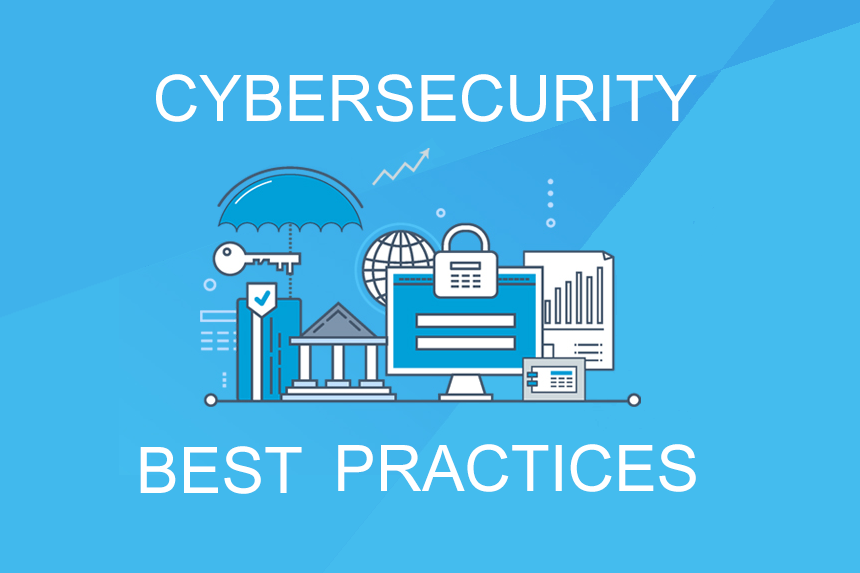
This image is property of www.bizstim.com.
Have an Incident Response Plan
Develop a comprehensive incident response plan
An incident response plan outlines the steps a business should take in the event of a security incident or data breach. It provides a structured approach to mitigate the impact, contain the incident, and initiate recovery processes. The plan should include clear roles and responsibilities, contact information for relevant stakeholders, and predefined communication channels. Develop a comprehensive incident response plan tailored to the specific needs of your business, and regularly update and test it to ensure its effectiveness.
Test the plan regularly
Creating an incident response plan is not enough; regular testing is crucial to validate its effectiveness. Conduct simulated exercises to test the plan’s response capabilities and identify any potential weaknesses or gaps. This allows businesses to refine their incident response procedures, validate their communication channels, and ensure that employees are familiar with their roles and responsibilities.
Train employees to respond to incidents
Employees play a vital role in responding to security incidents effectively. Provide regular training on how to recognize, report, and respond to potential security incidents. Employees should be aware of the steps to take in the event of a breach, such as isolating affected systems, preserving evidence, and reporting the incident to the appropriate personnel. By training employees, businesses can ensure a prompt and coordinated response to security incidents, minimizing their impact.
Backup and Recovery Processes
Regularly back up data
Regular data backups are crucial for protecting against data loss and ensuring business continuity in the face of unforeseen events. Implement automated backup solutions that regularly and securely back up critical data to both on-site and off-site locations. By maintaining up-to-date backups, businesses can quickly restore their systems and recover important data in the event of a hardware failure, natural disaster, or cyber attack.
Have a disaster recovery plan
A disaster recovery plan outlines the strategies and procedures to quickly recover critical systems and operations in the event of a major incident. It should include backup restoration procedures, priorities for system recovery, and a communication plan to inform stakeholders. Regularly review and update the disaster recovery plan to reflect changes in the business environment and ensure that it remains effective.
Test backups and recovery processes
Regularly test the restoration process by conducting backup and recovery drills. This helps ensure the integrity and accessibility of backup data and the effectiveness of recovery procedures. Testing backups and recovery processes allows businesses to identify and address any potential issues before they are faced with a real disaster. Regularly review and update backup schedules based on evolving business requirements and the criticality of data.
By implementing these cybersecurity practices, businesses can significantly strengthen their defenses against potential cyber threats. While no security measure can provide absolute protection, following these best practices helps reduce the likelihood of successful cyber attacks and minimizes the impact of any breaches that may occur. Prioritizing cybersecurity safeguards both the business and its stakeholders’ interests, ensuring the confidentiality, integrity, and availability of critical data and systems. Remember, cybersecurity is an ongoing effort that requires continuous monitoring, adaptation, and education to stay ahead of emerging threats.

